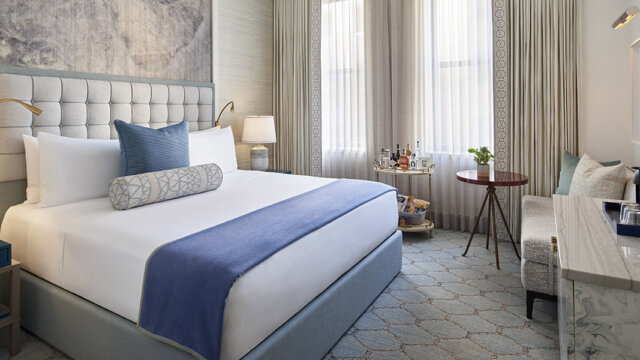One of the oldest forms of currency just may be making a comeback in the hospitality space. It just so happens that hotels have been making use of the barter system—trading what you have to get what you need—to assist with COVID recovery.
According to Bob Bagga, cofounder/CEO/president, BizX, the barter strategy can be used to preserve cash flow, use excess capacity and complete projects. We caught up with Bagga, a leader in the space, about his thoughts on the revival of the barter system:
Can you detail how the barter system works for hotels?
In most barter transactions, there is what we call a “double coincidence of wants.” Both parties have to have exactly what the other party needs or wants, proving to be ineffective in the long run. A hotel can trade empty room nights for a $20,000 advertising campaign, for example. But often, two parties that want to work together, in theory, can’t reach a 1:1 agreement.
In using a digital barter network like BizX, however, the network can facilitate how everyone gets what they need; for example, a hotel can sell excess products or services that can be used by other parties to purchase other budgeted products or services from other members.
Put simply, hotels require large amounts of cash to operate and be successful, and bartering provides a way to preserve that cash.
How have hotels been using the barter system to preserve cash flow during the pandemic, and how will this system help guide recovery?
A barter platform like BizX is a great alternative tool to monetize excess capacity by allowing hotels to turn empty room nights into budgeted expenditures. We’re another sales channel for these hotels to drive new high-value customers when there is availability, then they can use that budget to pay for other expenses.
This works because with hotels, most costs are fixed costs, and the marginal cost of an empty room is greater than that of a full room; so this helps increase a hotel’s occupancy rate and ancillary revenue, with transactions at their best available rate (BAR).
Because the cost of a room is marginal, now you can fund things or do things that you normally wouldn’t have been able to and pay for it with rooms that would’ve otherwise been empty. The marginal cost for the room may be less than 20%
In terms of specific types of transactions we’ve seen, there have been a great deal involving PPE, renovations and advertising in particular, using rooms that have been unsold.
Why is the industry seeing the resurgence of this system?
There has been more capacity and people are much more conscious about their cash. Smart hoteliers would always prefer to expense with a new customer filling your room as opposed to writing a check.
How do you advise hoteliers to lead a successful barter system?
They need to identify how much excess capacity they have and how much they want to allocate towards this, and then identify the where and when. For example, if you have a 100-room hotel with an average occupancy of 85%, and the average daily rate is $200, there are 15 rooms a night going empty—so that’s almost $1.1 million in lost revenue. So we’ll then work with you from there.
There are so many ways to use barter: food and beverage programs like wine, advertising, marketing, certain capital expenditures in some cases, etc. While barter has been around forever, it’s mainly been informal; a barter exchange like BizX actually manages the revenue and is not comped— it’s recognized as revenue and expense so it adds to your top line. A system like this is tightly controlled, transparent and sophisticated.
All of this business through our channel is incremental and isn’t replacing existing business, because we’re able to create demand, whether it’s incentive travelers or business travelers.
Why is it helpful in the hospitality industry, specifically?
In times of uncertainty or crisis when business may not be what it normally is there ends up being excess supply; in terms of hotels that means primarily hotel rooms, but it also means event spaces, tables at restaurants, etc. The hospitality industry is, unfortunately, one of the industries hit the hardest by crises like a pandemic, when restrictions limit travel, so businesses in this industry need to find any creative way they can to deal with their excess capacity and not hemorrhage money.
What does the future of this system look like for the industry? What can we expect?
We’re continuing to work more closely with hoteliers to be a part of their overall strategy when they’re looking at how it works; being a part upfront as opposed to integrating ourselves down the line. Technology is also obviously changing rapidly so we anticipate that will play an even greater role in future barter networks or platforms.
What are some hotel success stories you’ve seen that have used this system?
The Queen Anne Hotel in San Francisco, for instance, was able to use barter to maintain its antique furnishings while occupancy was lowered due to the pandemic. 360° Hotel Group—which manages a group of six properties including Springhill Suites by Marriott, Hampton Inn, Staybridge Suites and more—is currently undergoing landscaping projects which are 100% funded through barter.
Additionally, to decrease the amount of time customers and hotel staff spent in the same room during COVID-19, the hotel group created a program where hotel customers could “order their cleaning services,” similar to how they would order room service. To implement this program across all six properties, there was a large amount of printing, logos and signage that needed to happen, all of which was accomplished through barter.
Solmar Hotels & Resorts turned to BizX to create a new revenue stream by maximizing its excess capacity. In this case, rooms that ordinarily would be empty were now marketed to our members.
We have a variety of other members all over the world, including in Dubai, who’ve used barter for CCTV systems, renovations to buildings and carpet shampooing, and other more outside-the-box tactics.
(Note: Some hotel members who use barter prefer to remain confidential.)
What are common mistakes hotels make using the barter system? How do they correct those?
Not understanding how much actual capacity you have in dollar value, and leaving a lot of money on the table. Additionally, not being able to look at their capital and operating budgets to see where they can invest back in their brand or property; it’s like free money in many instances.
Not accounting for it properly is a problem as well; it is real revenue as opposed to a comp, and will help all of the metrics you’re trying to hit.
Is there anything else readers should know about the barter strategy in hospitality?
Utilizing a barter network can also help you give back to your team even if it’s simply gift cards or credit, can end up back with your employees through bonuses, which can be used on vacations, meals in restaurants or a variety of other services available.


